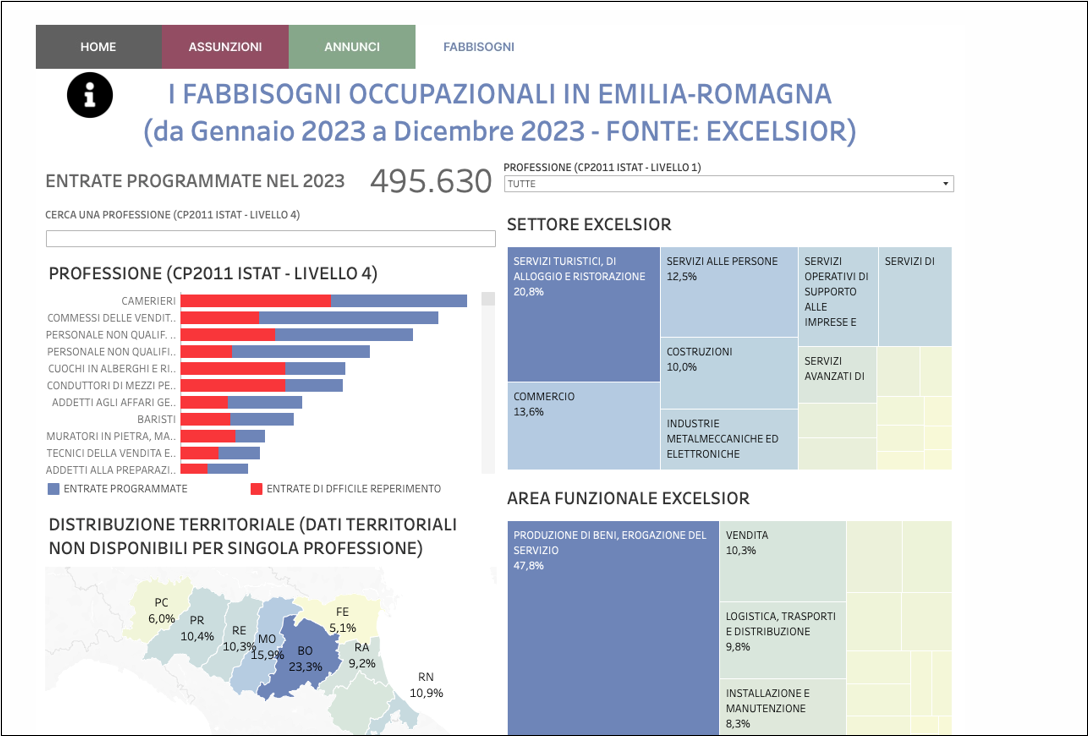The Italian labour market is on the brink of a major transformation, thanks to the government’s ambitious Piano Nuove Competenze (New Skills Plan). The end destination is clear: a modern workforce that meets employers' needs and fosters regional and national growth.
To achieve this, governmental institutions and enterprises must collaborate to promote continuous learning, upskilling and reskilling. However, as straightforward a concept as this is, training, upskilling, and reskilling strategies require a lot of investment. Without data, they can be an expensive shot in the dark. With this in mind, as part of its New Skills Plan, the Italian government is encouraging the use of labour market data to inform decisions and drive workforce strategies.
Recently, we have worked with two Italian organisations, ART-ER and Regione Lombardia, to create labour market dashboards backed by our data. The Italian government has highlighted these projects for their use of labour market data, making these regions’ skills strategies a reference for other Italian regions.
The New Skills Plan and its broader EU context
While the New Skills Plan targets a specific goal—addressing labour market challenges—it’s helpful to see how it fits into the bigger picture to gauge its full impact. The New Skills Plan was introduced as an extension of Piano Nazionale di Ripresa e Resilienza (PNRR) (National Recovery and Resilience Plan), which the Italian government formally implemented in 2021.
The PNRR is, in turn, part of the European Union’s Next Generation EU recovery package. This package supports the recovery from the COVID-19 impacts and covers various categories, from sustainability to innovation.
Back to the labour market, let’s take a closer look at what ART-ER and Regione Lombardia achieved with our data.
ART-ER: Solving the Skills Puzzle in Emilia-Romagna
Emilia-Romagna is the sixth-largest Italian region, covering the city of Bologna and eight other provinces. It is also one of Italy's leading regions in per capita income. But just because it has been named one of the richest regions over the last few years doesn’t mean it is immune to changes in the labour market.
ART-ER, short for Attractiveness Research Territory, is a joint consortium that aims to foster sustainable growth in the Emilia-Romagna region. ART-ER needed accurate data in an easy-to-digest format to understand current gaps in skills required by employees and available in the market. So, they partnered with Lightcast to develop a unique dashboard of labour market insights - formally known as the Skills Intelligence Emilia-Romagna tool.
This interactive tool covers various industries, from healthcare to greentech and tourism, and is split into three key areas:
-
Job Postings - referring to online job adverts offered in Emilia-Romagna in the last 12 months and their trends over time;
-
Recruitment - hirings, including occupations, contracts, education requirements, and experience levels (data provided by SILER Emilia-Romagna);
-
Requirements - planned revenues declared by regional companies (from Unioncamere's Excelsior information system).
By analysing online job vacancies and using new models for skills projections, ART-ER can identify the occupations that enterprises are struggling to find qualified candidates for, as well as occupations whose skills profile is likely to change a lot in the future.
The goal is to bridge the gap between demand and supply of skills, help enterprises understand their current and future challenges when attracting and hiring the right talent, and enable public organisations and education providers to implement effective training plans.
Ultimately, this data-backed dashboard is an essential component of an informed skills strategy for the region, allowing for efficient resource and investment allocation and higher success in fostering regional economic growth. The opportunities it unlocks are so significant that the Italian government has recognised this project as a reference for using skills intelligence for regional development.
"The Skills Intelligence Emilia-Romagna tool has allowed us to create a permanent platform for discussion and comparison with our local stakeholders for the quantitative and qualitative analysis of skills needs in Emilia-Romagna, enabling us to plan regional initiatives based on the evidence collected. Not only that, but thanks to the tool, we now have the opportunity to support training institutions and universities in the use of the skills intelligence approach to better respond to the needs of local companies."
Lara Porciatti, Senior Project Manager, ART-ER
Osservatorio Lombardia: A Dashboard with a Difference
Moving North, Lombardy is Italy’s leading industrial and commercial region and also the most populated, with over 10 million inhabitants. Including Italy's most prosperous city - the cultural, financial, and economic powerhouse that is Milan - the region is vital to Italy’s economic growth.
Lombardy’s thriving industries are always looking for top talent, and the region’s government is determined to keep pace with its growing demand for specialised skills. Regione Lombardia manages and develops the information systems for the Lombardy region.
They wanted to develop a digital, real-time platform for labour market updates in the Lombardy region. For this they turned to our partner, Intellera, to develop the dashboard with Lightcast providing the data that powers it.
The tool allows for the analysis of job advertisements published daily on the web and across any location within Lombardy. It provides highly detailed information about online job postings in the Lombardy region, including each posting’s source, industry, and job title for the advertised role. It also covers the experience and educational level required, the type of contract offered, and the skills candidates need to have. But it can go deeper than this, too.
For example, organisations can analyse the soft, hard, and digital skills required for each role and answer specific skills-related questions, such as:
What industry requires web development skills the most?
How many employers are looking for candidates with graphic design skills?
What are the most in-demand soft, hard, and digital skills for a software tester?
What are the top digital skills required across all industries?
What skills are not as in-demand as they used to be for a specific role?
The possibilities are truly endless, making it easy for organisations to find the answers to any labour market question through data. They can then use these insights to inform public policy or to implement learning and training strategies that align with Lombardy’s economic goals. This almost real-time data is compared with national statistics too to ensure consistency and accuracy, especially when defining long-term trends.
The Italian government’s emphasis on skills intelligence is part of a broader effort to use big data to modernise workforce policies. By giving policymakers the tools they need to address skills mismatches, this project is helping Lombardy stay ahead of the curve and meet national labour market goals.
Driving Government Skills Plans Forward with Lightcast
Any forward-thinking policy requires data to support it. Projects like ART-ER in Emilia-Romagna and Osservatorio Lombardia in the Lombardy region are contributing to the nation's efforts to fuel workforce transformation in Italy, ensuring the Italian labour market is strong and sustainable for years to come.
At Lightcast, we work with various public organisations to provide granular data and consulting services so they can understand their job market and support other regional organisations and private companies.
If you are looking for a data partner who offers not only the accurate and detailed data you need but also the industry expertise to turn this data into action, contact our team by filling out the form at the bottom of the page.
💡 Check out some more of our pieces looking at the Italian labour market:





